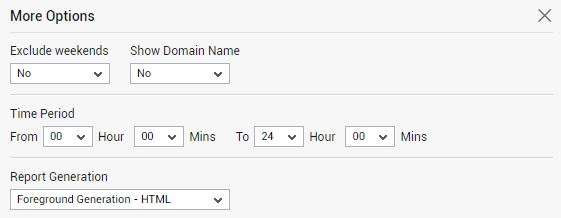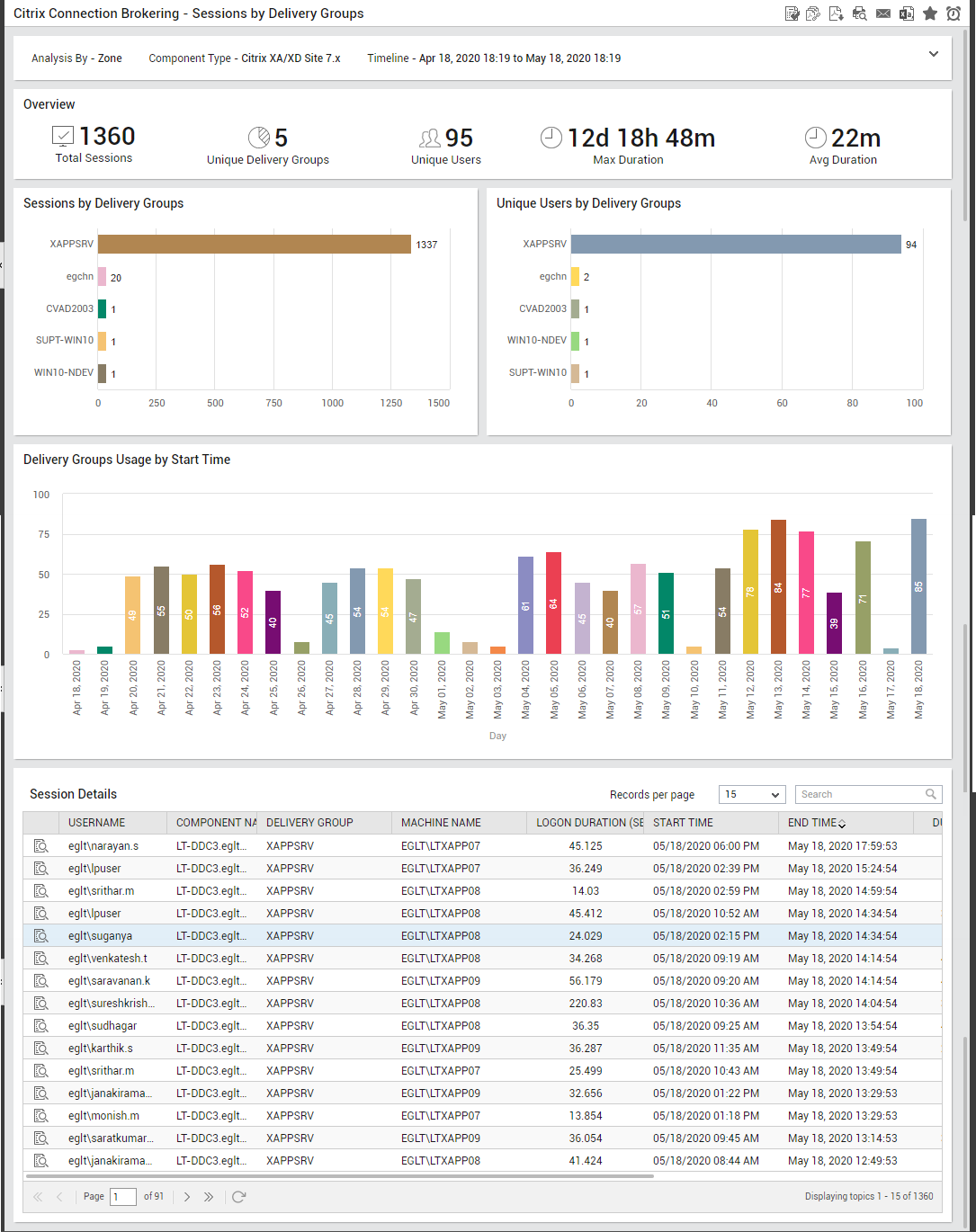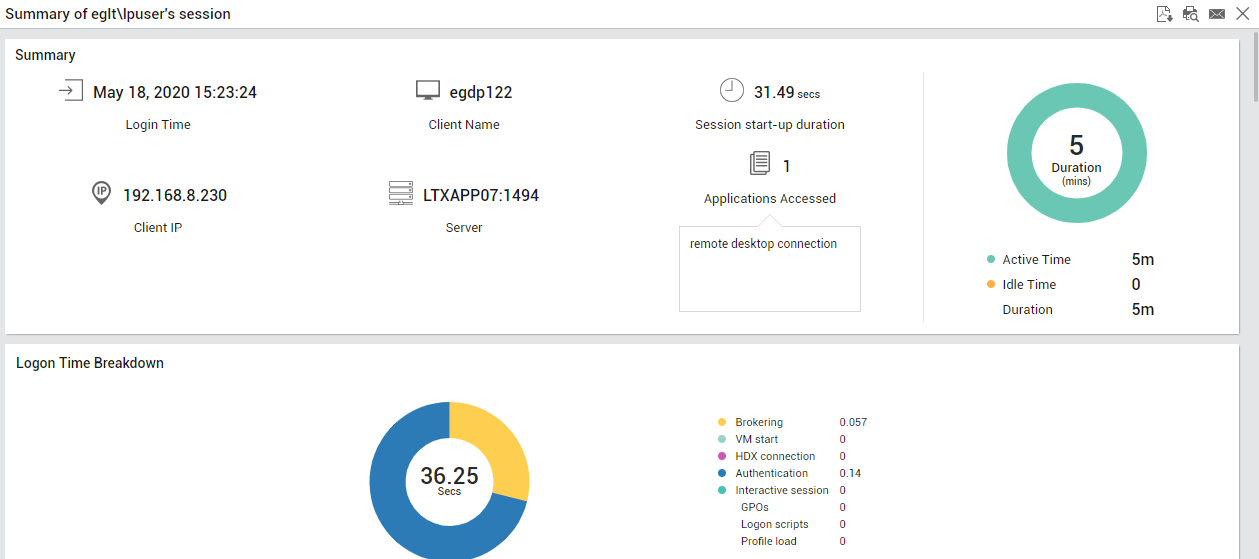Citrix Connection Brokering - Sessions by Delivery Groups Report
Use this report to historically analyze the session load on delivery groups, so you can quickly identify the delivery group that is the busiest in terms of the count of sessions it handles. The report also provides session-by-session details, with the help of which you can identify:
- the user who has initiated the maximum number of sessions;
- the machines that were accessed most frequently during the given period, the delivery group to which the machines belong, and the server hosting each machine;
- the user responsible for the longest session, the machine to which that user connected, and the client from which that connection was established;
The report also graphically represents the usage of delivery groups by the start time of sessions. Using this representation, you can easily figure out if an unusual/abnormal number of sessions was suddenly initiated on delivery groups during the chosen period, and if so, at what time exactly this anomaly occurred. This sheds light on suspicious user accesses.
To generate this report, do the following:
- Follow the menu sequence: REPORTS BY FUNCTION -> Domain-specific Reports -> Virtual Applications / Desktops (Citrix XenApp / XenDesktop) -> Citrix Connection Brokering -> Sessions by Delivery Groups.
-
Figure 1 then appears. In Figure 1, select a criteria for analysis from the Analyze By list box.

Figure 1 : Specifying the criteria for generating the Sessions by Delivery Groups report
-
Using this report, you can analyze the sessions on each delivery group available on one/more managed components, or those that are part of a zone, service or segment. The options provided by the Analyze By list box are discussed hereunder:
- Component: Select this option to choose the component(s) from across all the managed components in the environment.
- Zone: To generate a report for one/more components that are included in a zone, pick the Zone option. A Zone drop-down list will then appear, from which you would have to select the zone to which the components of interest to you belong. A Sub zone flag also appears. Indicate whether the components present within the sub-zones of the chosen zone are also to be to be considered for report generation, by setting the Sub zone flag to Yes.
- Segment: If you want to generate a report for one/more chosen components that belong to a segment, select the Segment option from Analyze By list box, and then pick the Segment from the drop-down list that appears.
- Service: If you want to generate a report for one/more components involved in the delivery of a service, select the Service option from Analyze By, and then pick the required Service from the drop-down list that appears.
- Choose a Component Type for which the report is to be generated.
- The Components list will now be populated with all the components that are managed in your environment for the chosen component type. If the Components list consists of too many components, then viewing all the components and selecting the ones you need for report generation could require endless scrolling. To avoid this, you can click the
 button next to the Components list. A Components pop up window will then appear using which you can view almost all the components in a single interface and Select the ones to be included in this report.
button next to the Components list. A Components pop up window will then appear using which you can view almost all the components in a single interface and Select the ones to be included in this report. - The Delivery Groups list will now be populated with all the delivery groups that are configured for the chosen components. If the Delivery Groups list consists of too many delivery groups, then viewing all the delivery groups and selecting the ones you need for report generation could require endless scrolling. To avoid this, you can click the
 button next to the Delivery Groups list. A Delivery Groups pop up window will then appear using which you can view almost all the components in a single interface and Select the ones to be included in this report.
button next to the Delivery Groups list. A Delivery Groups pop up window will then appear using which you can view almost all the components in a single interface and Select the ones to be included in this report. -
Then, specify the Timeline for generating this report. You can either provide a fixed time line such as 1 hour, 2 days, etc., or select the Any option from the list to provide a From and To date/time for report generation.
Note:
For every user registered with the eG Enterprise system, the administrator can indicate the maximum timeline for which that user can generate a report. Once the maximum timeline is set for a user, then, whenever that user logs into eG Reporter and attempts to generate a report, the Timeline list box in the report page will display options according to the maximum timeline setting of that user. For instance, if a user can generate a report for a maximum period of 3 days only, then 3 days will be the highest option displayed in the Timeline list - i.e., 3 days will be the last option in the fixed Timeline list. Similarly, if the user chooses the Any option from the Timeline list and proceeds to provide a start date and end date for report generation using the From and To specifications, eG Enterprise will first check if the user's Timeline specification conforms to his/her maximum timeline setting. If not, report generation will fail. For instance, for a user who is allowed to generate reports spanning over a maximum period of 3 days only, the difference between the From and To dates should never be over 3 days. If it is, then, upon clicking the Run Report button a message box will appear, prompting the user to change the From and To specification.
-
In addition to the settings discussed above, this report comes with a set of default specifications. These settings are hidden by default. If you do not want to disturb these default settings, then you can proceed to generate the report by clicking the Run Report button soon after you pick one/more components for report generation. However, if you want to view and then alter these settings (if required), click on the
 icon. The default settings will then appear in the MORE OPTIONS drop down window (See Figure 2). The steps below discuss each of these settings and how they can be customized.
icon. The default settings will then appear in the MORE OPTIONS drop down window (See Figure 2). The steps below discuss each of these settings and how they can be customized.
-
If the timeline specified for the report needs to exclude the data collected during the Weekends, then set Exclude weekends to Yes. If not, select No.
Note:
By default, the weekend constitutes Saturday and Sunday. To override this default setting, do the following:
- Edit the eg_report.ini file in the <EG_INSTALL_DIR>\manager\config directory.
- In the [EXCLUDE_WEEKEND] section of the file, the Days parameter is set to Saturday,Sunday by default. You can modify this by setting the Days parameter to a comma-separated list of other days of the week - say Friday,Saturday.
- Save the file after making the required changes.
- By default, the generated report will not display the domain to which a user who has initiated the session belongs to. To this effect, No option is chosen from the Show Domain Name list. If you want to list the name of the domain to which the user belongs to in the generated report, then, choose Yes from this list.
-
Next, indicate the report Time period.
Note:
By default, the Time period is set to 24 hours. Accordingly, the From and To parameters in the [timeframe] section of the eg_report.ini file (in the <eg_install_dir>\manager\config directory) are set to 00:00 and 24:00 respectively. If need be, you can override this default setting by configuring a different timeframe against the From and/or To parameters.
-
In large environments, reports generated using months of data can take a long time to complete. Administrators now have the option of generating reports on-line or in the background. When a report is scheduled for background generation, administrators can proceed with their other monitoring, diagnosis, and reporting tasks, while the eG manager is processing the report. This saves the administrator valuable time. To schedule background processing of a report, you can either select the Background Save - PDF option from the Report Generation list. To process reports in the foreground, select the Foreground Generation - HTML option from this list.
Note:
- The Report Generation list will appear only if the EnableBackgroundReport flag in the [BACKGROUND_PROCESS] section of the eg_report.ini file (in the <EG_INSTALL_DIR>\manager\config directory) is set to Yes.
- The default selection in the Report Generation list will change according to the Timeline specified for the report. If the Timeline set is greater than or equal to the number of days specified against the MinDurationForReport parameter in the [BACKGROUND_PROCESS] section of the eg_report.ini file, then the default selection in the Report Generation list will be Background Save - PDF. On the other hand, if the Timeline set for the report is lesser than the value of the MinDurationForReport parameter, then the default selection in the Report Generation list will be Foreground. This is because, the MinDurationForReport setting governs when reports are to be processed in the background. By default, this parameter is set to 2 weeks - this indicates that by default, reports with a timeline of 2 weeks and above will be processed in the background.
- Click the Done button if any changes were made to the More Options drop down window.
- Finally, click the Run Report button to generate the report.
-
If the Report type is Foreground Generation - HTMLand Yes option is chosen from the Show Domain Name list, then Figure 3 will appear as soon as you click the Run Report button.

Figure 3 : The generated Sessions by Delivery Groups report
The generated report (see Figure 3) comprises of the following sections:
- The Overview section reveals the total number of sessions initiated during the chosen time period, the unique delivery groups and the unique users who initiated the sessions. Administrators can also figure out the maximum duration for which a session remained connected and the average duration of the sessions.
- The Sessions by Delivery Groups reveal a bar graph that provides the count of sessions that were initiated by the users of each delivery group. Using this graph, administrators can figure out the delivery group from which the users initiated the maximum number of sessions.
- The Unique Users by Delivery Groups section reveals a bar graph that reports the count of unique users that are part of the delivery group. This graph helps administrators analyze the delivery group that contained the maximum number of unique users.
- The Delivery Groups Usage by Start Time section reveals the usage of delivery groups by the start time of sessions. Using this representation, you can easily figure out if an unusual/abnormal number of sessions was suddenly initiated on delivery groups during the chosen period, and if so, at what time exactly this anomaly occurred.
-
The Session Details section reveals the following :
- the user who has initiated the maximum number of sessions;
- the machines that were accessed most frequently during the given period, the delivery group to which the machines belong, and the server hosting each machine;
- the user responsible for the longest session, the machine to which that user connected, and the client from which that connection was established;
Clicking on the
 icon in Figure 3 will reveal Figure 4.
icon in Figure 3 will reveal Figure 4.
Figure 4 : The Summary of a user's session
Figure 4 will provide a summary of the user's session which will provide a graphical representation of the logon time, idle time and the logon time break up details. The application accessed by the user is also revealed.
